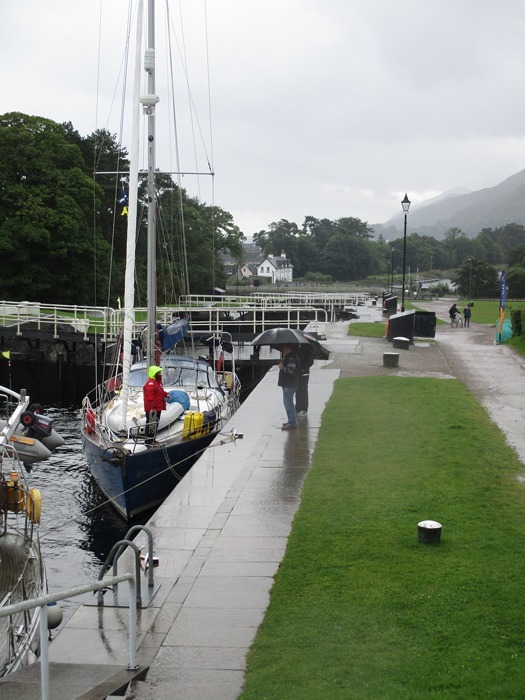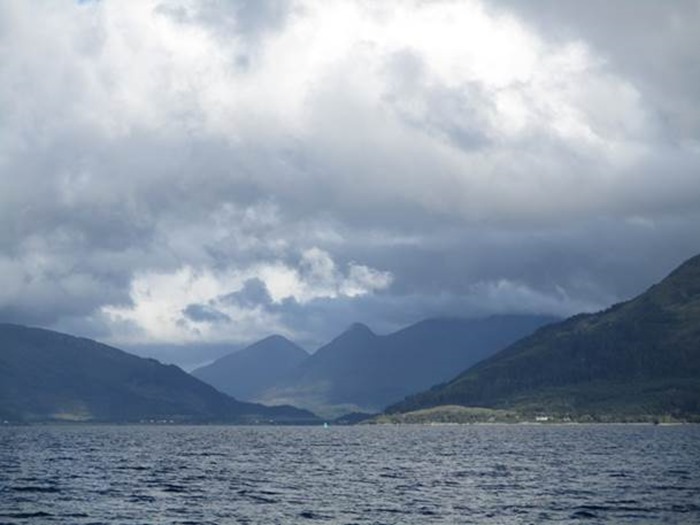The Caledonian Canal

|
The Caledonian Canal cuts through the Great Glen of the Scottish Highlands from the Corpach Basin near Fort William to the Clachnaharry Sea Lock at Inverness. It includes the famous Loch Ness as well as Loch Lochy, the jauntily named Loch Oich and Loch Dochfour which lie in perfect alignment. The Glen is a massive geological fault tearing through the underlying rock and resulting in these four deep lochs; it links the Atlantic to the North Sea through over 60 miles of outstanding Scottish landscape. The transit needs time, a boat can be taken through in 2½ days but that would be a rush, the scenery demands longer and there is plenty to see.
Work started in 1803 to build this canal so that naval and other sailing vessels could make passage from the Atlantic to the North Sea without having to face the treacherous waters of the Pentland Firth and Cape Wrath; we were quite pleased not to have to contend with those given the current state of the weather. The Caledonian is the foremost canal in Scotland with such august names as William Jessop (who died before its completion) and Thomas Telford to its credit, although many other engineers were involved as it went furiously over budget and wasn’t fully completed until 1847. It has long locks, 46 metres, but by the time of completion steamships had got much bigger so that they couldn’t use the canal; sounds like a familiar scenario. Anyway, it helped develop the Highland economy as it enabled better trade between east and west as well as some with Northern Europe and Scandinavia. Now it is also an important feature of the tourist trade in this part of the world but that is obviously very weather dependent, we saw very little boat traffic although there were quite a few walkers about and some canoeists.
Other visitors touring the Highlands arrive by road to various towns and villages along the canal which is very attractive so local business seems to do well especially those selling tartan & tweed goods, whisky and the usual souvenirs like tea towels. Restaurants are very good at promoting local produce as a key feature which benefits their trade: venison, haggis, Cullen Skink, fish, smoked fish and other sea-food is in abundance. We’re hooked on Cullen Skink, a delicious soup of smoked fish, leeks and a broth laced with cream. Neptune’s Staircase, a flight of 8 locks carrying boats upward at the start of the canal is a very popular stop for tourists.
The lochs are full of highland beauty; they run past the Cairngorms and Ben Nevis although our weather was such that there probably weren’t many mountaineers about. Ben Nevis is in there somewhere!
A highland home on the loch side…..
…..and rather nicely unobtrusive little holiday lodges
We spent a black and silent night anchored in a small bay near the River Garry in Loch Oich. The highlight of the lochs though was Loch Ness with all its history and mystery to think about whilst sailing through. At the western end is Fort Augustus, a vibrant small town which has plenty to offer but leaving its flight of 5 downward locks behind the canal opens out into Loch Ness
.........and as the day cooled the clouds descended
We never did see Nessie, just a gigantic lizard like thing which swam under the boat and seemed to slither into the depths below.
Other overnight stops in the canal were spent on the pontoons at the canal side or just before and after lock gates. Here we were provided with hot showers and laundry rooms, and sometimes with a pub or restaurant nearby to help the evening along.
The canal keepers no longer have use of the pretty lock-keepers cottages, now they have small wooden sheds.
Most of the keepers work hard to keep their locks looking pretty good. The keeper of the lock below felt that the damp weather made mowing the lock sides rather like painting the Forth road bridge, no sooner finished than it all had to be started again.
All these locks are electrically operated unlike those of the Crinan Canal. There are plenty of swing or sliding bridges to get through as well so there is often a bit of waiting about and it helps to call up the lock and bridge keepers in advance. Loch Dochfour brought us to the last stretch of canal which took us downwards through a flight of 4 locks at Muirtown. We stopped just after this and had a couple of days at the Seaport Marina visiting Inverness and the local area before taking the sea lock out into the North Sea. Clachnaharry Sea Lock
|












